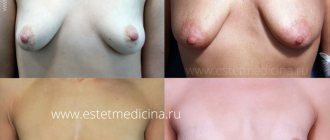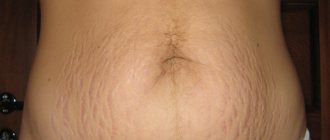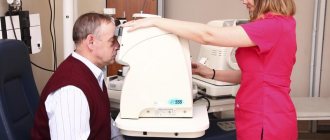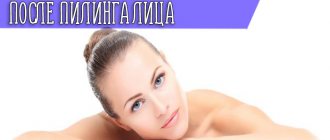Why do breasts sag after lactation?
The phenomenon of sagging breasts is called mastoptosis (ptosis).
There is no muscle in the female breast; it consists of ducts, glands, adipose tissue and Cooper's ligaments, and is enclosed in a fasciocutaneous membrane. The shape of the gland and its elasticity are determined by the condition of three components: Cooper's ligaments, fascia and skin. During pregnancy, the mammary gland develops and the breasts increase in size. After childbirth, during lactation, milk is produced, which increases the weight of the breast by 270–520 grams. This creates additional stress on the ligaments. As a result of prolonged excessive load, the ligaments are stretched and do not return to their original position after feeding, which leads to mastoptosis.
The second reason is a change in hormonal metabolism. After childbirth, breastfeeding significantly increases the production of oxytocin. This hormone stimulates the proliferation of fat cells and fat deposition, including in the mammary glands, which also increases their weight and affects sprains.
Degrees of mastoptosis
The inframammary fold is the area at the base of the breast where the skin meets the rib cage. The nipple is normally located 5–7 cm above the fold under the breast, the so-called inframammary fold. There are several degrees of breast ptosis, which are determined by the position of the nipple-areolar complex:
- I - the nipple is localized at the level of the inframammary fold, the sagging is not noticeable;
- II - localization of the nipple below the pectoral fold, mastoptosis becomes noticeable;
- III - the nipple is lowered down, the mammary glands are localized below the inframammary fold by more than 5 cm, ptosis is very pronounced.
Separately, pseudoptosis is distinguished when the mammary glands are located below the pectoral fold, and the nipple with the areola is above it. This phenomenon is typical for women with large glands.
If you want to determine the presence of mastoptosis, use a regular pencil, placing it under the mammary gland. In its normal form, the pencil falls.
A set of 5 proven exercises
In order to have toned breasts, it is not enough to pay attention only to the pectoral muscles. The back muscles also need to be used when performing exercises. A slouched back always gives a visual sensation of sagging breasts, so you need to select exercises that pump up the muscles of the entire corset:
Push ups
It is one of the most effective exercises for working out the area of interest to us. If you cannot do the classic version , push-ups from your knees or push-ups from the wall are suitable for you.
Detailed instructions on how a girl can learn to do push-ups from scratch are here.
- We lie down flat on the floor.
- Place the palms of the hands under the chest, fingers pointing upward.
- Leaning on your toes and palms, push your body off the floor, fully straightening your arms. You cannot bend your lower back - your body should be straight like a plank.
You need to perform ten repetitions in two to three approaches.
We start push-ups with several exercises. When the muscles begin to strengthen, we increase the amount. Rest time is up to thirty seconds.
Dumbbell Bench Press
Includes large and small muscles. We definitely recommend that you familiarize yourself with the 4 most common myths about the effect of the “Bench Press” on women’s breasts.
- Squatting down with a straight back, we take dumbbells from the floor. Straightening our legs at the knees, we rise.
- We place the dumbbells on the hips and lie with our backs on the gymnastic bench. We spread our legs slightly and rest our feet on the floor. Bring the dumbbells to your chest.
- Straightening your arms at the elbows, as you exhale, raise your arms with dumbbells up. Perform eight repetitions in several sets.
This is one of the 7 best dumbbell exercises for the chest. We start by performing several repetitions, gradually increasing their number. The time to relax the muscles is one minute.
Incline bench fly
The layout not only works on the area of interest to us, but also perfectly removes fat from the armpits.
- To work the lower part of the chest muscles, raise the corner of the bench up. To work the upper part of the muscles, lower the corner of the bench down.
- Ask your partner to hand you dumbbells and place them in the chest area. Press the dumbbells up and out to the sides. Elbows point down all the time.
- Bring the dumbbells together at the top while exhaling.
Perform eight repetitions, doing several sets.
We start by performing several exercises, gradually increasing the number of repetitions. Time for relaxation is one minute.
Bent-over row
We work the corset muscles. About the benefits of “Thrust” for women and 3 types, see here.
- We squat and take dumbbells from the floor with a straight grip.
- We bend our knees slightly and pull the dumbbells up from the middle of the shin to the waist.
- We tilt the body at an obtuse angle. If we use traction while bending at a right angle, there will be a large load on the lower back.
- We make the effort (traction) while exhaling.
First, we select the minimum weight of dumbbells. The number of exercises is ten times using several approaches.
How to restore breasts after breastfeeding
The most effective and common way to return the mammary gland to its previous shape is surgery. To do this, it is tightened. The operation is called mastopexy. It can be performed after breastfeeding has been completed and weight has normalized, when excess fat deposits in the breast area have disappeared.
About methods of plastic surgery
Lifting is carried out in several ways, the choice of which is determined by the degree of mastoptosis. Three main methods of performing the operation have been developed.
Periareolar method
Mastopexy is performed in this way only for grade I ptosis. An incision is made around the circumference of the areola. Through the resulting access, the gland tissues are redistributed so that the nipple-areolar complex is pulled up and takes its original position. The glandular tissue is fixed, and cosmetic sutures are placed on the incision. After healing they are almost invisible.
Vertical technique
For stage II mastoptosis, an incision is made first around the areola, then down vertically to the submammary fold. After this, the breast tissue is redistributed, they are tightened, raised to the upper pole and secured. The areola and nipple are also tightened. To improve the aesthetics of the gland, if necessary, the areola can be reduced.
Anchor (T-shaped) technique
In grade III, ptosis is performed in the form of an anchor. This method is considered classic.
The incision is made first along the edge of the areola, then vertically downwards, and then along the submammary fold. During surgery, the gland tissue is shifted to the upper pole, the new position is fixed on the pectoral fascia, excess skin is removed, and the nipple-areolar complex is moved upward.
Breast lift with breast augmentation
It often happens that after breastfeeding, breasts not only lose their shape, but also decrease in size. This is due to a decrease in the volume of the gland after feeding, if there is not enough adipose tissue in the breast. In this case, the breasts are not only tightened, but also enlarged. Breast lifting and augmentation are performed in one operation.
Augmentation mammoplasty is performed in two ways: by installing an endoprosthesis or by lipofilling—transplanting one’s own fat into the gland.
Breast augmentation with implants is performed in four ways:
- subglandular - the endoprosthesis is installed behind the gland;
- subfascial - the implant is placed under the fascia (the connective tissue membrane of the pectoral muscle);
- subpectoral - the implant is partially located under the muscle, and partially under the gland;
- submuscular (axillary) - a breast prosthesis is placed under the pectoralis major muscle.
The choice of placement method depends on the degree of ptosis, skin elasticity and other factors. The anatomical features of the chest and muscles are also taken into account.
Lipofilling is performed for breast enlargement by a maximum of one and a half sizes. The advantages of such a surgical intervention include the ability to get rid of excess fat tissue in problem areas, since the biomaterial for the operation is the patient’s fat, taken from areas of its deposition on the body.
Breast lift at the same time as breast reduction
After childbirth and lactation, breasts can increase significantly in size. If the breasts sag significantly, cause discomfort and negatively affect the general condition, mammary reduction is performed simultaneously with a breast lift - plastic surgery to reduce breast size. With such a surgical intervention, before redistributing and fixing the breast tissue, some of it is removed, excess skin is excised, the nipple-areolar complex is pulled up, and the areola is reduced if necessary.
Eliminating asymmetry
Breastfeeding is called one of the acquired causes of asymmetry of the mammary glands. This is often due to the fact that the baby is attached to one breast more often, or the second has a less comfortable nipple grip for the baby. Mastopexy is often combined with breast correction, eliminating its asymmetry. If the mammary glands are of significant volume, then symmetry is restored by removing excess volume from one gland and securing the nipple-areolar complex at the same height. When combining mastopexy with breast augmentation, asymmetry is eliminated by choosing the right implants. In some cases, they resort to lipofoling, that is, transplanting the patient’s fat, but this technique gives a temporary result.
Correction of the nipple-areolar complex
After breastfeeding, not only the breast skin can stretch, but also the areola and nipple. Correction of the nipple-areolar complex will help change the size of the areolas and their shape, restore symmetry, and reduce the pigmented area. It is usually performed by excision of excess areola or nipple with the application of invisible cosmetic sutures.
With gigantomastia, when huge breasts are pulled up and reduced to normal size, it is usually impossible to move the nipples and areolas up. This is often why they are removed. This decision is made by the doctor together with the patient before surgery. The plastic surgeon shapes the new nipple from the skin in the right place. Then the newly formed nipple and the area around it are tattooed.
Still have questions? Ask them to a specialist
Plastic surgeon Vladimir Krugly will answer all your questions
Ask a Question
Top 5 methods for tightening problem areas
Is it possible to tighten breasts after breastfeeding? Many proven remedies used in combination with gymnastics will help.
Establishing proper nutrition
While feeding the child, the woman ate for two, since the baby received all the nutrients from her milk. But after finishing the feeding process, the diet should be changed towards reducing calorie content. There are special diets to maintain breast shape. Take advantage of them.
Many women gain weight after giving birth. In this case, you need to change your approach to nutrition: use more raw and stewed vegetables, boiled chicken and fish.
Consumption of all types of cabbage – white cabbage, cauliflower, broccoli. This is very useful for the female body. Cabbage should definitely be included in your menu several times a week, both raw and stewed. We have already discussed the 7 most beneficial foods for breast enlargement.
It is good to eat dishes from different cereals in reasonable quantities, as they contain many essential vitamins and minerals. Fish oil is a must for consumption after lactation!
It is necessary to limit the consumption of fast carbohydrates, that is, those dishes and products that contain sugar. It is better not to eat confectionery, sweets, sweet drinks, or mayonnaise at all. If you want to treat yourself to something sweet, you can eat a handful of dried fruits.
Scrubs and masks
You need to take care of your breasts in the same way as your face - regularly, carefully and with love. The following products will help us strengthen and tighten the skin of the breast - exfoliating scrubs and tightening masks for the bust .
Exfoliating scrubs can be done once every ten days. For this purpose, we will use products that can be bought at the pharmacy. You can make a scarifying mixture yourself.
Mix sea salt with a small amount of vegetable oil. Gently and carefully distribute over the surface of the bust using massaging movements, leave for a while and rinse off in the shower. Sugar can be used as a scrub for very delicate skin. This scrub must be done before applying any product - mask or cream.
How to make breasts firmer after breastfeeding? Here are the 5 best nourishing masks:
- Pour half a glass of oatmeal with a glass of hot milk , let stand, then apply warm to the skin of the chest, rubbing in with light movements. Wrap yourself in a towel. This mask acts for twenty minutes and has an exfoliating and nourishing effect. Rinse off the mask in the shower and apply nourishing cream or baby oil.
- the fatty cottage cheese so that there are no lumps in it. Add some hot milk and the egg yolk, then mix well. Apply to the skin of the bust, rubbing in with light movements. You need to keep this mask for half an hour. Rinse off in the shower and apply any nourishing cream or a special cream to restore the bust. The product smoothes and nourishes the skin of the breast.
- the beeswax in a water bath, add olive oil. We take the ingredients in equal parts. Apply warmly to the chest area and keep for half an hour. This mask can not be washed off, but carefully removed with a napkin.
- Laminaria wrap. Mix a tablespoon of seaweed with hot water, let stand for ten minutes and apply to the skin of the chest. Cover the top with cling film. The action time is approximately fifteen to twenty minutes. The product has a whitening and tightening effect.
- the boiled beans thoroughly with a spoon, adding vegetable oil and a few drops of lemon juice. Lightly rubbing, apply to the bust for half an hour, wrap in a towel. The mask nourishes and tightens the breast skin, evens out skin color, and removes age spots. This mask is also good to use for the face. Just like beans, you can use mashed potatoes.
It is recommended to alternate masks for better results.
See also: TOP 5 gels for breast lift after childbirth. Review of the 7 most popular bust firming creams - how effective are they?
Massage
A special massage has a good effect on the chest after breastfeeding. 7 anti-cellulite massage techniques here. Remember the basic rules:
- It should be carried out with light, stroking and sliding movements.
- Lubricate the skin of the bust with peach or apricot oil. Using sliding movements, use your fingertips to massage the bust in the direction from the nipple to the collarbone, then from the nipple to the armpit. This massage is suitable for loose or stretched skin.
Carefully! Rubbing and kneading the décolleté area are excluded, as they can not only stretch the skin, but also lead to injury.
Cold and hot shower
This is one of the simplest and most effective remedies that improves blood circulation, skin condition, strengthens the immune system and promotes weight loss. It can be used for the chest area and the entire body. Remember the basic rules:
- You need to start with a small temperature difference between hot and cold water. That is, use alternating warm and cool water. After some time, the temperature difference must be gradually brought to hot and cold water.
- It is necessary to finish the dousing with cold water.
- If you constantly practice contrast showers, you will soon enjoy positive changes: your chest and whole body will become more toned.
Attention! Exposure to cold water should be half as long as hot water.
Swimming in the pool
A great way to tighten your breasts.
Swimming is beneficial both for the development of the muscles that support the bust and for the skin of the chest.
Those who constantly practice exercises in the pool and love water treatments usually do not suffer from excess weight and have toned muscles.
Breast lift after breastfeeding without surgery
A few tips will help you quickly restore your breast shape after lactation.
Proper nutrition.
To create favorable conditions for restoring breast shape, a balanced diet is necessary. It should always be balanced. To restore the elasticity of Cooper's ligaments, you should include brawn and jellied meat in the menu. It should have enough meat, fish, eggs. Vegetables and fruits are required as a source of vitamins and fiber. But it’s better to exclude fast, or simple, carbohydrates. This applies to baked goods and sweets.
Underwear.
It is very important to choose underwear so that it reduces stress on the ligaments and supports heavy glands. The bra should not squeeze the breasts. To do this, you need to choose the right size and models with wide straps.
Skin moisturizing.
Breast ptosis depends on the condition of not only the ligaments, but also the skin. To prevent it from losing its elasticity, in addition to a balanced diet, it is necessary to maintain a drinking regime. You can use moisturizing cosmetics.
Physical exercise.
They help strengthen the muscles of the back and chest, as well as improve blood microcirculation in the gland itself, which will help avoid significant ptosis.
Tip 6: Give your child maximum attention
When completing lactation, try to give your baby as much attention as possible. With your affection and love, you will show that stopping breastfeeding will not change the relationship between you. After all, breasts for a baby are not only a source of nutrition, but also a way to calm down, feel needed and loved.
Polina Lykova: “It is also undesirable, in order to complete lactation as quickly as possible, to hand over the child to grandmothers for a while or go away yourself, tell a story about a “sick” breast (smearing it with brilliant green, etc.), and also make fun of the child, comparing him with other children. By doing this you can frighten him and violate his trust.”
Prevention of ptosis during pregnancy and breastfeeding
To maintain the original shape of the breasts and prevent stretch marks, preventive measures should be taken from the first weeks of pregnancy. There are a few simple rules:
- The bra should not put pressure on the mammary glands. I recommend choosing nursing models with wide straps and no wires. As your breasts increase, the size of your underwear should be increased. Throughout the second half of pregnancy, as well as the entire lactation period, try to wear a bra around the clock.
- A nourishing cream will help maintain the tone of the skin of the mammary glands. A cream with lanolin, which moisturizes the skin and maintains its elasticity, gives a good result.
- I do not recommend doing chest strengthening exercises during pregnancy. They will lead to stretching of the fascial skin sheath of the gland.
- During pregnancy and breastfeeding, maintain a normal weight, as excess adipose tissue leads to stretching of the skin and fascia.
- Prevent milk stagnation, try to maintain the same volume on each side, to do this, alternately place the baby on both mammary glands when feeding.
- Do not take long breaks between feedings; express excess milk on time. If your child does not eat at night, empty both glands before bed.
- Use a breast pump to express. If you perform this procedure manually, try not to stretch the skin.
Symptoms of the disease
Signs of lactostasis can be divided into two groups: at an early stage and after inflammation has begun (in advanced form). Immediately after the blockage of the duct appears, the woman feels:
- chest pain;
- compaction in the area of one or more lobes;
- slight tissue swelling.
Departure is paid separately - from 550 rubles
Request a call
Call:
+7 (499) 455-08-05
Sometimes it happens like this: there is pain and swelling of the tissue, but there is no compaction. This happens with a slight lactostasis, which went away on its own. For example, milk stagnation occurred at night, and in the morning you fed the baby, and it resolved.
How to understand that inflammation has begun
More advanced lactostasis, which can only be treated with the help of a specialist, is often accompanied by a pronounced inflammatory process. Its symptoms:
- skin redness;
- increased body temperature;
- severe pain;
- bad feeling;
- heaviness in the chest;
- feeling of fullness of the gland.
If you have lactostasis, then the temperature will remain at 37-37.5 degrees. If it becomes higher, then this is a sign of the development of infectious mastitis. After the lobes and ducts are emptied, the temperature will drop within a few hours.
Tip 8: If feeding needs to be completed urgently, act delicately
It happens that a mother urgently needs to wean her baby from the breast. This may be due to pregnancy, forced long separation of mother and child, illness or treatment of the mother that is incompatible with breastfeeding. In this case, lactation must be stopped abruptly.
How to proceed? Express breasts when full until soft or relieved, but not completely. With each new pumping, milk will leave the breast. This will help avoid lactostasis and mastitis in the mother.
At this time, it is better to transfer the child to artificial feeding or give him expressed milk from a bottle, or finally transfer him to adult food.
During the completion of lactation, it is very important for the mother to demonstrate confidence in her actions, because a positive attitude is half the success!











